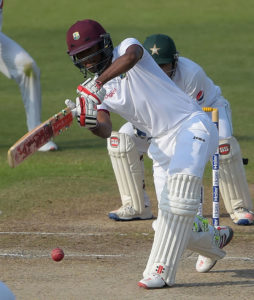By Garth Wattley
In Sharjah this week, Kraigg Brathwaite’s slender shoulders grew as broad as Samson’s of biblical fame. Refusing to be moved, he knocked down for the belaboured West Indies a wall that has stood for some 26 years, helping to deliver a five-wicket win over Pakistan, their first against that opponent away from home since 1990.
Test cricket was still being played in Pakistan when a team led by Desmond Haynes won in Faisalabad by seven wickets. It is a sporting irony that arguably the weakest West Indies side to face Pakistan on foreign soil should be able to match what a team stacked with legends did.
Brathwaite’s work in Sharjah could come to define his career. Bettering his most resolute self, his ten and a half hours at the crease in the third Test for 142 and 60, both not out, ensured that his bowlers’ work in this series finally paid off.
The problem of bowling teams out with regularity had reached crisis proportions over the last 12 months for West Indies, especially in the series away to Australia and at home to India. When it was announced they were going to a region traditionally unkind to seamers, it did not inspire confidence that such impotence would be overcome.
But in the UAE, West Indies eventually achieved success on the back of their bowling. Big contributions from different members of the attack kept them in all three Tests, and almost set up a win in the first, in Dubai.
In that first game, Devendra Bishoo’s 8 for 49 was also career-defining, and it turned a Pakistan walkover into a compelling match that Darren Bravo’s sheet-anchor 116 threatened to convert into a storied West Indies win.
Perhaps the aggressive, slightly complacent Pakistan batsmen played a part in the turnaround, but that second-innings Bishoo effort changed the series for West Indies. Bravo built on the momentum his team-mate had started. And while he could not take his heroics all the way, the visitors went to the second Test with greater self-belief.
While Bishoo deferred to Shannon Gabriel in Abu Dhabi, where the big fast bowler got his first five-wicket haul in all first-class cricket, the leggie had a platform on which to build. Injury and lack of faith by the selectors have stymied his progress since his debut against Pakistan five years ago. Bishoo’s seven wickets in the final Test ought to buy him time so he can truly settle down.
His effort, and captain Jason Holder’s second-innings five-for in Sharjah, ensured that the targets in front of the side’s unsteady batting line-up were not too challenging. And it was the ability of the bowlers to progressively get at the Pakistan batting that will encourage Holder and the selection panel.
The more sustained threat of Gabriel as a result of an improved fitness regime and greater balance on delivery is bringing him better results.
The decline of the injury-plagued Kemar Roach and the retirement from Tests of Jerome Taylor have left the already depleted West Indies fast bowling stocks in a critical state. They desperately need Gabriel to stay fit, and to find a reliable new-ball partner for him.

Teenager Alzarri Joseph, the Under-19 hero, was given his second game in the third Test. He will have to be carefully managed, but sooner rather than later must be given the chance to establish himself alongside Gabriel.
Bravo’s excellent first-Test effort of 87 and 116 demonstrated the kind of leadership in batting that West Indies require of him. But, not for the first time, he was unable to keep to those high standards in the other two Tests.
While Bravo did at least distinguish himself, the same could not be said for team veteran Marlon Samuels, who averaged just 23.83 in the series, and did not shoulder the burden a player of his experience and expertise should. That meant the pressure was all on Bravo at No. 3 and Brathwaite at the top of the order. Brathwaite has also not been helped by the lack of a steady, productive opening partner.
Those are significant problems for a side woefully short of Test match experience. From captain to wicketkeeper, West Indies are a team of on-the-job trainees. As such, they are getting their share of hard knocks.
“People forget this is a very, very young side. When you look at the number of players under 25, it is unbelievable that a side in Test cricket could be so young,” bowling coach Roddy Estwick reminded the world. “But it’s a good thing, and once the people of the Caribbean and the selectors remain patient, I think we’ve got the making of a pretty decent side in 12 to 18 months.”
Estwick was speaking in the absence of a head coach. Phil Simmons, if anyone needs reminding, was removed just before West Indies left for the UAE for their series. Turmoil and inevitable negative fallout followed, so that the Test side entered their final match searching for the team’s only win all tour. That they managed to secure it was to their great credit.
The last time West Indies had beaten a side above them in the rankings away from home was back in 2007, when South Africa were surprised in Port Elizabeth, where Samuels engineered a 128-run victory.
But just as West Indies’ transformation in the Pakistan Tests could not have been predicted, so also is the future progress of this team. Consistent selectors and broad-minded administrators in West Indies cricket are just hard to find. (ESPNCricinfo)
Cover photo caption: Leg-spinner Devendra Bishoo’s 18 wickets in the three Tests should allow him to enjoy a longer, more settled run in the Test side © Getty Images







